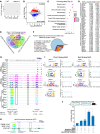Stromal Pbrm1 mediates chromatin remodeling necessary for embryo implantation in the mouse uterus
- PMID: 38426493
- PMCID: PMC10904057
- DOI: 10.1172/JCI174194
Stromal Pbrm1 mediates chromatin remodeling necessary for embryo implantation in the mouse uterus
Abstract
Early gestational loss occurs in approximately 20% of all clinically recognized human pregnancies and is an important cause of morbidity. Either embryonic or maternal defects can cause loss, but a functioning and receptive uterine endometrium is crucial for embryo implantation. We report that the switch/sucrose nonfermentable (SWI/SNF) remodeling complex containing polybromo-1 (PBRM1) and Brahma-related gene 1 (BRG1) is essential for implantation of the embryonic blastocyst on the wall of the uterus in mice. Although preimplantation development is unaffected, conditional ablation of Pbrm1 in uterine stromal cells disrupts progesterone pathways and uterine receptivity. Heart and neural crest derivatives expressed 2 (Hand2) encodes a basic helix-loop-helix (bHLH) transcription factor required for embryo implantation. We identify an enhancer of the Hand2 gene in stromal cells that requires PBRM1 for epigenetic histone modifications/coactivator recruitment and looping with the promoter. In Pbrm1cKO mice, perturbation of chromatin assembly at the promoter and enhancer sites compromises Hand2 transcription, adversely affects fibroblast growth factor signaling pathways, prevents normal stromal-epithelial crosstalk, and disrupts embryo implantation. The mutant female mice are infertile and provide insight into potential causes of early pregnancy loss in humans.
Keywords: Endocrinology; Epigenetics; Fertility; Reproductive biology; Sex hormones.
Conflict of interest statement
Figures








Similar articles
-
Chronic Exposure to Bisphenol A Affects Uterine Function During Early Pregnancy in Mice.Endocrinology. 2016 May;157(5):1764-74. doi: 10.1210/en.2015-2031. Epub 2016 Mar 29. Endocrinology. 2016. PMID: 27022677 Free PMC article.
-
The NR2F2-HAND2 signaling axis regulates progesterone actions in the uterus at early pregnancy.Front Endocrinol (Lausanne). 2023 Aug 18;14:1229033. doi: 10.3389/fendo.2023.1229033. eCollection 2023. Front Endocrinol (Lausanne). 2023. PMID: 37664846 Free PMC article.
-
Analysis of heart and neural crest derivatives-expressed protein 2 (HAND2)-progesterone interactions in peri-implantation endometrium†.Biol Reprod. 2020 Apr 24;102(5):1111-1121. doi: 10.1093/biolre/ioaa013. Biol Reprod. 2020. PMID: 31982918
-
Novel pathways for implantation and establishment and maintenance of pregnancy in mammals.Mol Hum Reprod. 2010 Mar;16(3):135-52. doi: 10.1093/molehr/gap095. Epub 2009 Oct 30. Mol Hum Reprod. 2010. PMID: 19880575 Free PMC article. Review.
-
Epigenetic control of embryo-uterine crosstalk at peri-implantation.Cell Mol Life Sci. 2019 Dec;76(24):4813-4828. doi: 10.1007/s00018-019-03245-8. Epub 2019 Jul 27. Cell Mol Life Sci. 2019. PMID: 31352535 Free PMC article. Review.
Cited by
-
Endometrial stromal Menin supports endometrial receptivity by maintaining homeostasis of WNT signaling pathway through H3K4me3 during WOI.Commun Biol. 2025 Jul 4;8(1):995. doi: 10.1038/s42003-025-08434-9. Commun Biol. 2025. PMID: 40610728 Free PMC article.
-
Understanding epigenetic regulation in the endometrium - lessons from mouse models with implantation defects.Epigenomics. 2025 Jun;17(8):541-554. doi: 10.1080/17501911.2025.2491298. Epub 2025 Apr 14. Epigenomics. 2025. PMID: 40228031 Review.
-
Mettl3/Eed/Ythdc1 regulatory axis controls endometrial receptivity and function.Commun Biol. 2025 Feb 11;8(1):215. doi: 10.1038/s42003-025-07667-y. Commun Biol. 2025. PMID: 39934221 Free PMC article.
References
-
- Xin QL, et al. Transcriptional activation of nuclear estrogen receptor and progesterone receptor and its regulation. Sheng Li Xue Bao. 2016;68(4):435–454. - PubMed
MeSH terms
Substances
LinkOut - more resources
Full Text Sources
Molecular Biology Databases
Research Materials
Miscellaneous

